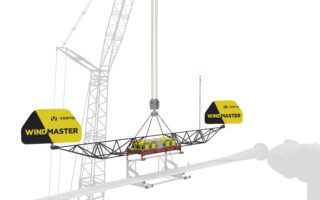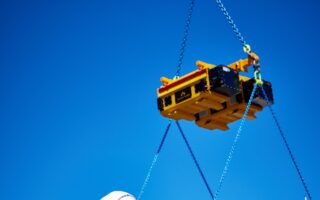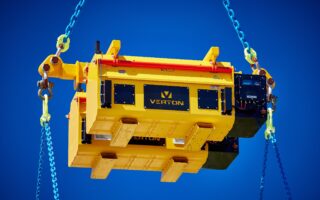Verton Australia’s solid foundation set to make global offshore lifting operations a breeze with locally manufactured solution
Have you ever tried to thread a needle while jumping on a trampoline? Now imagine trying to install a 60 meter long, 20-tonne wind turbine blade, 100m above sea-level while floating several kilometres out at sea.
Verton, an Australian manufacturer behind world-leading lifting and load orientation products is developing a solution for this seemingly impossible task where precision handling of heavy loads, in strong winds and from unstable working conditions creates a challenging work environment.
Estimated to be worth up to a Trillion (US) dollars by 20401, the offshore wind-generation market presents Verton with a prime opportunity to address growing safety and productivity concerns relating to installation and maintenance with their Windmaster project.
This project leverages Verton’s significant experience in construction and load lifting environments to develop a solution for wind turbine installations in challenging environments, with $178,000 in co-funding from the Federal Government’s Advanced Manufacturing Growth Centre (AMGC) assisting the company’s commercialisation plans.
Core to their solution is a patented, remote-controlled, gyroscope enabled product, which delivers simpler and safer lifting, rotation and orientation of heavy loads. The Verton solution allows for the removal of ‘taglines’ (supporting lines run from the load to ground level) and ‘dogmen’ (who operate taglines form the ground). These traits are particularly important when installing motors and blades to wind-turbines in off-shore environments, where space and safety are paramount.
In user testing and field deployment, Verton’s technology has been proven to reduce equipment downtime by 25 percent, and hook-time (time of loads in the air) by up to 50 percent, resulting in significant productivity and safety gains, while also reducing equipment downtime and potential for damage – benefits which are unparalleled in the sector.
Managing Director for the Advanced Manufacturing Growth Centre (AMGC), Dr Jens Goennemann said that Verton is a prime example of an Australian manufacturer developing innovative solutions for global customers.
“The winds of change are blowing in global energy generation and Verton is a role model for other companies looking to leverage its experience in new sectors both here and abroad, while tapping into opportunities in the growing renewable energy market.
“By collaborating with best of breed researchers and industry partners to identify business opportunities, Verton is set to export locally developed craning and lifting solutions into numerous international markets,” said Goennemann.
As a result of the project, Verton has linked with multinational companies Mammoet, a heavy lifting and transport specialist, marine engineers Van Oord, and wind power specialist Vestas, as well as Australian SME suppliers, all of which are financial contributors to the project alongside AMGC.
“Through the AMGC-backed project, we scaled up the loads we can handle with the Everest system, from 25-tonne capacity to deploying a proof-of-concept for our Windmaster solution for testing at Brisbane Airport which will be capable of significantly higher loads,” explained Patrick Taylor, Project Manager at Verton.
“The proof-of-concept test will help us develop the best product for high-wind environments, where we use the wind against itself, rather, than try to fight it,” said Taylor.
Demonstrating the deep collaborative links is the integration of Verton’s Windmaster system to Vestas’s multi-blade installer yoke technology. Combined, the system can be used to help lift blades, nacelles, turbines and other large components.
Verton’s willingness to collaborate has been key to its success so far, said Esna Louwrens, the company’s Global Business Development and Marketing Manager.
A concept by founder and CTO Stanley Thomson, a lifting industry professional with nearly four decades’ experience, greatly benefited from input from Queensland University of Technology academics.
“When we started, we needed calculations for the moment of inertia, and then to take that and integrate it into our software and to make our products work like they are working today,” she added.
“There is a vast amount of physical and computational complexity involved in getting it right.”
Verton continues its engagement with QUT roboticists and other specialists on other projects, as well as with industrial field experts.
The company is growing its headcount from 11 at the start of the year to 25 in the next three months. Louwrens said the team has a heavy representation of engineers in software, firmware, mechatronics, mechanical and other disciplines.
Goennemann said it is pleasing to see Australian manufacturers creating complex solutions for global markets by embracing the entire manufacturing value-chain while demonstrating where Australian manufacturers can thrive.
“It has been proven time and time again that manufacturers, like Verton, who invest in all seven-steps of the manufacturing value-chain develop products which are better, not cheaper and have global relevance –they are proof positive of Australia’s manufacturing potential,” said Goennemann.
1Offshore Wind Tracking Report, June 2020. International Energy Agency – https://www.iea.org/reports/offshore-wind



